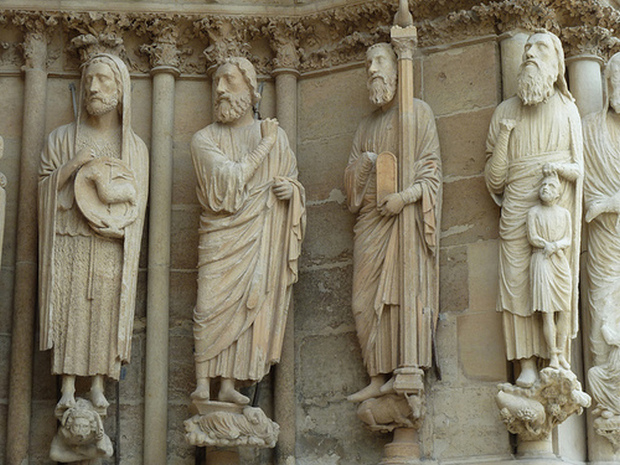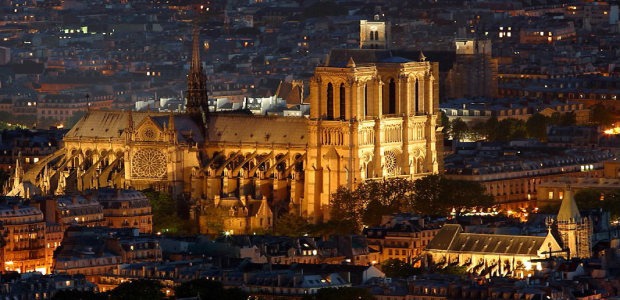The monumental Gothic cathedral of Notre-Dame dominates the skyline of a small market town. But the inspiration for its design continues to baffle historians. The magnificent 12th-century cathedral in the northern French town of Chartres is an age-old enigma. Few who visit fail to be moved by its powerful aura. For Notre-Dame Is a giant riddle, an equation to be solved, yet one expressed not on paper but given form in stone blocks and glass stained with such consummate skill that even today, more than 800 years after the cathedral was built, its beauty still stuns visitors. Pious Christians continue to attend services here, and architects and historians visit the cathedral in an attempt to unravel its mysteries.
Construction of the present cathedral began after a fire in 1194, but the site on which Notre-dame stands has long fulfilled spiritual needs. In the belief that they could somehow harness he Earth’s energy, prehistoric builders had erected a dolmen (two or three sturdy, unhewn stones topped by a large flattish one) at Chartres. It was held that all who entered the dolmen’s chamber would be revitalized by the Earth’s natural forces. In time, the site – which also encompassed a well and a mound built nearby – came to be reversed as holy ground.

Later, but still in pre-Christian times, the Druids (the Celtic priests of Gaul and Britain) established a college at Chatres which became a centre for their teachings. In response to a prophetic vision, these ancient priests carved a wooden statue of a virgin and child which they named the Virgin under the Earth. Christians discovered the statue, blackened with age, in the third century and thereafter worshipped it as the Black Virgin. It was on this sacred ground that the first of the churches dedicated to Our Lady was constructed, so inaugurating a series of buildings on the site, the culmination of which is the Gothic masterpiece that stands here today.
Chartres is a study in symbolism. The roof over the nave and apse presents a cross to the heavens while the two towers may be interpreted as the fingers of God. The ground plan was probably designed using the Golden Number, 1.618. Distances between pillars, and the lengths of the nave, transepts and the choir, are all multiples of this figure.
The impressive use of the flying buttress at Chartres set the standard for others to follow. This Gothic innovation permitted the construction of a high, arched roof by absorbing some of the stress that would otherwise force supporting walls and pillars outwards. Not only did this create an overall effect of space, it also meant that extensive areas of stained glass could be incorporated into the design without compromising the structural integrity of the whole.

Some 2000 sculpted figures adorn the porches and portals of Notre-Dame. The naturalistic poses and the occasional blending of sacred and secular subjects reveal a distinct Gothic influence. Often the identities of the medieval craftsmen who created them are unknown, but features common to Chartres’ figures are also found in those in the Cathedrals of Angers, Le Mans, Bourges and Senlis, suggesting that the same hands may have been responsible.

Theories abound as to the source of inspiration for the present cathedral. Legend has it that the advanced architectural knowledge necessary to build such a structure in medieval times was brought from the East by the original Knights Templar. These were nine French knights who were persuaded by Bernard of Clairvaux, founder of the Cistercian Order of monks, to abandon their worldly possessions and go in search of the secrets’ believed to be buried in the holy sanctuary under the ruins of Solomon’s Temple in Jerusalem. During their ten-year search, the knights were suspected of dabbling in the occult.
When they returned to France in 1128 it was rumored that they had found the Ark of the Covenant, a chest reputed to contain the secrets of the Divine Law governing number, weight and measure, including the so-called Golden Number, 1.1618. the ratio of 1:1.618, the Golden Section or Mean, was judged to be particularly aesthetically pleasing and governs much of the art and architecture of the Renaissance and later. Certainly the knights’ return coincided with the initial flowerings of Gothic architecture in Europe, and construction of the first Gothic cathedral at Chartres began six years later.
In 1194 a fire destroyed most of the new structure, but within the following 30 years, a team of masons, glaziers, sculptors, geometers, astronomers and other craftsmen had replaced it with an immense shrine, whose position, proportions, orientation, and symbolism have stimulated the psyche and refreshed the spirit of visitors ever since.
Chartres’ stained-glass windows are some of the finest in the world. The Virgin forms the centerpiece of Notre-Dame-de-la-Belle-Verriere, ‘Our Lady of the Beautiful Glass’, situated in the choir. The windows are all the more remarkable because the artist could not properly ‘see’ his work until it was installed when it was too late to make changes.

The ‘sacred centre’ of the cathedral lies between the second and third bays of the choir. This is where the altar originally stood. Around 121ft (37m) below the sacred centre is the water in the Druid’s well. Towering exactly the same distance above the sacred centre is the pinnacle of the cathedral’s Gothic vault.
No one knows whether this symmetry was intentional or merely coincidental, but that does not detract from the spiritual potency of the place. It is said to possess the power to transform people and to transmute them into a higher spiritual state, just as alchemists were reputed to transmute base metal into gold. Pilgrims arriving at the threshold of the cathedral, the Great West Door, found that they stood more upright with their heads raised high. For the interior of the cathedral seems to have an uplifting effect on the body, as if to prepare those who enter for the mysterious Earth energies emanating from below and divine inspiration from above.
Although the true nature of the cathedral’s spiritual significance may forever remain a mystery, its earthly significance is apparent in its many imitations, including Reims, Bourges, Amiens, and Beauvais. And while these cathedrals may be more worthy architecturally, the intrinsic fascination of Chartres is unique.
-end-





































Gorgeous
It is isn’t it! Some all-time favorite games like Tomb Raider, Assassin’s Creed gives us a wonderful and close up encounter with such architecture and places.
Indeed. Wish I could visit these places.